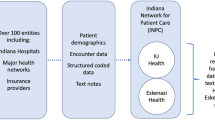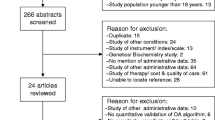Abstract
Objective
Prior studies on the epidemiology of Whipple’s disease are limited by small sample size and case series design. We sought to characterize the epidemiology of Whipple’s disease in the USA utilizing a large population-based database.
Methods
We queried a commercial database (Explorys Inc, Cleveland, OH), an aggregate of electronic health record data from 26 major integrated healthcare systems in the USA. We identified a cohort of patients with a diagnosis of Whipple’s disease based on systemized nomenclature of medical terminology (SNOMED CT) codes. We calculated the overall and age-, race-, ethnicity, and gender-based prevalence of Whipple’s disease and prevalence of associated diagnoses using univariate analysis.
Results
A total of 35,838,070 individuals were active in the database between November 2012 and November 2017. Of these, 350 individuals had a SNOMED CT diagnosis of Whipple’s disease, with an overall prevalence of 9.8 cases per 1 million. There was no difference in prevalence based on sex. However, prevalence of Whipple’s disease was higher in Caucasians, non-Hispanics, and individuals > 65 years old. Individuals with a diagnosis of Whipple’s disease were more likely to have associated diagnoses/findings of arthritis, CNS disease, endocarditis, diabetes, malignancy, dementia, vitamin D deficiency, iron deficiency, chemotherapy, weight loss, abdominal pain, and lymphadenopathy.
Conclusions
To our knowledge, this is the largest study to date examining the epidemiology of Whipple’s disease. In this large population-based study, the overall prevalence of Whipple’s disease in the USA is 9.8 cases per 1 million people. It affects men and women at similar rates and is more common in Caucasians, non-Hispanics, and people > 65 years old.


Similar content being viewed by others
Abbreviations
- SNOMED CT:
-
Systematized nomenclature of medicine clinical terms
- CNS:
-
Central nervous system
- HIV:
-
Human immunodeficiency virus
- HLA:
-
Human leukocyte antigen
- OR:
-
Odds ratio
- CI:
-
Confidence interval
- ICD-9:
-
International classification of diseases-9
References
Durand DV, Lecomte C, Cathebras P, Rousset H, Godeau P. Whipple disease. Clinical review of 52 cases. The SNFMI research group on whipple disease. Societe nationale francaise de medecine interne. Medicine. 1997;76:170–184.
Schoniger-Hekele M, Petermann D, Weber B, Muller C. Tropheryma whipplei in the environment: Survey of sewage plant influxes and sewage plant workers. Applied and Environmental Microbiology. 2007;73:2033–2035.
Fenollar F, Trani M, Davoust B, et al. Prevalence of asymptomatic tropheryma whipplei carriage among humans and nonhuman primates. The Journal of Infectious Diseases. 2008;197:880–887.
Ehrbar HU, Bauerfeind P, Dutly F, Koelz HR, Altwegg M. PCR-positive tests for tropheryma whippelii in patients without whipple’s disease. Lancet (London, England). 1999;353:2214.
Street S, Donoghue HD, Neild GH. Tropheryma whippelii DNA in saliva of healthy people. Lancet (London, England). 1999;354:1178–1179.
Zinkernagel AS, Gmur R, Fenner L, Schaffner A, Schoedon G, Schneemann M. Marginal and subgingival plaque–a natural habitat of tropheryma whipplei? Infection. 2003;31:86–91.
Dutly F, Altwegg M. Whipple’s disease and “tropheryma whippelii”. Clinical Microbiology Reviews. 2001;14:561–583.
Amsler L, Bauernfeind P, Nigg C, Maibach RC, Steffen R, Altwegg M. Prevalence of tropheryma whipplei DNA in patients with various gastrointestinal diseases and in healthy controls. Infection. 2003;31:81–85.
Marth T, Roux M, von Herbay A, Meuer SC, Feurle GE. Persistent reduction of complement receptor 3 alpha-chain expressing mononuclear blood cells and transient inhibitory serum factors in whipple’s disease. Clinical Immunology and Immunopathology. 1994;72:217–226.
Ectors N, Geboes K, De Vos R, et al. Whipple’s disease: A histological, immunocytochemical and electronmicroscopic study of the immune response in the small intestinal mucosa. Histopathology. 1992;21:1–12.
Marth T, Neurath M, Cuccherini BA, Strober W. Defects of monocyte interleukin 12 production and humoral immunity in whipple’s disease. Gastroenterology. 1997;113:442–448.
Marth T, Kleen N, Stallmach A, et al. Dysregulated peripheral and mucosal Th1/Th2 response in whipple’s disease. Gastroenterology. 2002;123:1468–1477.
Schneider T, Stallmach A, von Herbay A, Marth T, Strober W, Zeitz M. Treatment of refractory whipple disease with interferon-gamma. Annals of Internal Medicine. 1998;129:875–877.
Ectors NL, Geboes KJ, De Vos RM, et al. Whipple’s disease: A histological, immunocytochemical, and electron microscopic study of the small intestinal epithelium. The Journal of Pathology. 1994;172:73–79.
Bai JC, Sen L, Diez R, et al. Impaired monocyte function in patients successfully treated for whipple’s disease. Acta Gastroenterologica Latinoamericana. 1996;26:85–89.
Moos V, Schmidt C, Geelhaar A, et al. Impaired immune functions of monocytes and macrophages in whipple’s disease. Gastroenterology. 2010;138:210–220.
Maiwald M, von Herbay A, Persing DH, et al. Tropheryma whippelii DNA is rare in the intestinal mucosa of patients without other evidence of whipple disease. Annals of Internal Medicine. 2001;134:115–119.
Schinnerling K, Moos V, Geelhaar A, et al. Regulatory T cells in patients with whipple’s disease. Journal of Immunology (Baltimore, Md.: 1950). 2011;187:4061–4067.
Schinnerling K, Geelhaar-Karsch A, Allers K, et al. Role of dendritic cells in the pathogenesis of whipple’s disease. Infection and Immunity. 2015;83:482–491.
Desnues B, Lepidi H, Raoult D, Mege JL. Whipple disease: Intestinal infiltrating cells exhibit a transcriptional pattern of M2/alternatively activated macrophages. The Journal of Infectious Diseases. 2005;192:1642–1646.
Desnues B, Ihrig M, Raoult D, Mege JL. Whipple’s disease: A macrophage disease. Clinical and Vaccine Immunology: CVI. 2006;13:170–178.
Desnues B, Raoult D, Mege JL. IL-16 is critical for tropheryma whipplei replication in whipple’s disease. Journal of Immunology (Baltimore, Md.: 1950). 2005;175:4575–4582.
Moos V, Kunkel D, Marth T, et al. Reduced peripheral and mucosal tropheryma whipplei-specific Th1 response in patients with whipple’s disease. Journal of Immunology (Baltimore, Md.: 1950). 2006;177:2015–2022.
Trotta L, Weigt K, Schinnerling K, et al. (2017). Peripheral T-cell reactivity to heat shock protein 70 and its cofactor GrpE from tropheryma whipplei is reduced in patients with classical whipple’s disease. Infection and Immunity, 85(8), https://doi.org/10.1128/iai.00363-17. Print 2017 Aug.
Schneider T, Moos V, Loddenkemper C, Marth T, Fenollar F, Raoult D. Whipple’s disease: New aspects of pathogenesis and treatment. The Lancet. Infectious Diseases. 2008;8:179–190.
Fenollar F, Puechal X, Raoult D. Whipple’s disease. The New England Journal of Medicine. 2007;356:55–66.
Dobbins WO III. Whipple’s Disease. Springfield: Charles C Thomas; 1987.
von Herbay A, Otto HF, Stolte M, et al. Epidemiology of whipple’s disease in germany. Analysis of 110 patients diagnosed in 1965–95. Scandinavian Journal of Gastroenterology. 1997;32:52–57.
Marth T. Systematic review: Whipple’s disease (tropheryma whipplei infection) and its unmasking by tumour necrosis factor inhibitors. Alimentary Pharmacology and Therapeutics. 2015;41:709–724.
Lagier JC, Lepidi H, Raoult D, Fenollar F. Systemic tropheryma whipplei: Clinical presentation of 142 patients with infections diagnosed or confirmed in a reference center. Medicine. 2010;89:337–345.
Moos V, Schneider T. Changing paradigms in whipple’s disease and infection with tropheryma whipplei. European Journal of Clinical Microbiology & Infectious Diseases: Official Publication of the European Society of Clinical Microbiology. 2011;30:1151–1158.
Gunther U, Moos V, Offenmuller G, et al. Gastrointestinal diagnosis of classical whipple disease: Clinical, endoscopic, and histopathologic features in 191 patients. Medicine. 2015;94:e714.
Mori K, Ando I, Kukita A. Generalized hyperpigmentation of the skin due to vitamin B12 deficiency. The Journal of Dermatology. 2001;28:282–285.
Louis ED, Lynch T, Kaufmann P, Fahn S, Odel J. Diagnostic guidelines in central nervous system whipple’s disease. Annals of Neurology. 1996;40:561–568.
Matthews BR, Jones LK, Saad DA, Aksamit AJ, Josephs KA. Cerebellar ataxia and central nervous system whipple disease. Archives of Neurology. 2005;62:618–620.
Elkins C, Shuman TA, Pirolo JS. Cardiac whipple’s disease without digestive symptoms. The Annals of Thoracic Surgery. 1999;67:250–251.
Gubler JG, Kuster M, Dutly F, et al. Whipple endocarditis without overt gastrointestinal disease: Report of four cases. Annals of Internal Medicine. 1999;131:112–116.
Fenollar F, Lepidi H, Raoult D. Whipple’s endocarditis: Review of the literature and comparisons with Q fever, bartonella infection, and blood culture-positive endocarditis. Clinical Infectious Diseases: An Official Publication of the Infectious Diseases Society of America. 2001;33:1309–1316.
Lepidi H, Fenollar F, Dumler JS, et al. Cardiac valves in patients with whipple endocarditis: Microbiological, molecular, quantitative histologic, and immunohistochemical studies of 5 patients. The Journal of Infectious Diseases. 2004;190:935–945.
Altman D. Practical statistics for medical research. London: Chapman and Hall; 1991.
MedCalc. (2016). Odds ratio calculator. Retrieved December/5, 2017, from https://www.medcalc.org/calc/odds_ratio.php.
Dobbins WO III. Whipple’s disease: an historical perspective. Q J Med.. 1985;56:523–531.
Enzinger FM, Helwig EB. Whipple’s disease. Whipple’s Disease. 1963;336:238.
Puechal X. Whipple disease and arthritis. Current Opinion in Rheumatology. 2001;13:74–79.
Explorys team. “We unlock the power of BIG DATA to improve healthcare for everyone”. Explorys. 2015. Accessed March 15, 2018. https://www.explorys.com/about-us.html.
Nadkarni PM, Darer JA. Migrating existing clinical content from ICD-9 to SNOMED. Journal of the American Medical Informatics Association: JAMIA. 2010;17:602–607.
Kaelber DC, Foster W, Gilder J, Love TE, Jain AK. Patient characteristics associated with venous thromboembolic events: A cohort study using pooled electronic health record data. Journal of the American Medical Informatics Association: JAMIA. 2012;19:965–972.
Author information
Authors and Affiliations
Contributions
JAE and EM contributed to study conception and design; JAE and EM are involved in acquisition of data; JAE, EM, MA, and GSC analyzed and interpreted the data; JAE, EM, and GSC drafted the manuscript; EM and GSC critically revised the manuscript; JAE and EM were involved in statistical analysis; GSC obtained the funding; and GSC supervised the study.
Corresponding author
Ethics declarations
Conflict of interest
Jamie Ann Elchert, Emad Mansoor, Mohannad Abou-Saleh, and Gregory S. Cooper declare that they have no conflict of interests.
Appendix
Appendix
Abdominal pain included SNOMED CT codes for abdominal pain, generalized abdominal pain, chronic abdominal pain, acute abdominal pain. Malignancy included SNOMED CT codes for malignant neoplastic disease, neoplastic disease, primary malignant neoplasm. Seizure included SNOMED CT codes for seizure, seizure disorder, generalized seizure, partial seizure, epileptic seizure, and seizure-related finding. Iron deficiency included SNOMED CT codes for iron deficiency and iron deficiency anemia. Ataxia included SNOMED CT codes for ataxia and cerebellar ataxia. Skin hyperpigmentation included SNOMED CT codes for disorder of skin pigmentation. Hypoalbuminemia included SNOMED CT codes for hypoalbuminemia. Diabetes included SNOMED CT codes for diabetes mellitus, diabetes mellitus without complication, type 2 diabetes mellitus, type 1 diabetes mellitus. Vitamin B 12 deficiency included SNOMED CT codes for vitamin B12 deficiency (non-anemic) and cobalamin deficiency. Vitamin D deficiency included SNOMED CT codes for vitamin D deficiency. Myocarditis included SNOMED CT codes for myocarditis, acute myocarditis, viral myocarditis, bacterial myocarditis. Pericarditis included SNOMED CT codes for pericarditis. Dementia included SNOMED CT codes for dementia, presenile dementia, senile dementia, uncomplicated senile dementia, uncomplicated presenile dementia, senile dementia with delirium, and presenile dementia with delirium. Lymphadenopathy included SNOMED CT codes for lymphadenopathy, cervical lymphadenopathy, thoracic lymphadenopathy, pelvic lymphadenopathy, mediastinal lymphadenopathy, hilar lymphadenopathy, lymphadenopathy of head and/or neck. Chemotherapy included SNOMED CT codes for chemotherapy, antineoplastic agent, intravenous chemotherapy, intramuscular chemotherapy, subcutaneous chemotherapy. Weight loss included SNOMED CT codes for abnormal weight loss, weight loss finding, weight decreased. HIV included SNOMED CT codes for human immunodeficiency virus infection and HIV positive. Arthritis included SNOMED CT codes for arthritis, arthralagia of upper arm, arthropathy, arthralgia of the lower leg, arthralgia of the pelvic region and thigh, arthralgia of the ankle and/or foot. CNS disease included SNOMED CT codes for disorder of the nervous system. Immunosuppression included SNOMED CT codes for immunosuppressant, immunosuppressives, immunomodulator, immunotherapeutic agent. Diarrhea included SNOMED CT codes for diarrheal disorder, diarrhea, chronic diarrhea, diarrhea and vomiting, acute diarrhea, infectious diarrheal disease, functional diarrhea, nausea/vomiting/and diarrhea, irritable bowel syndrome with diarrhea. Endocarditis included SNOMED CT codes for endocarditis or endocardial disease. HLA-B27 included SNOMED CT codes for HLA-B27.
Rights and permissions
About this article
Cite this article
Elchert, J.A., Mansoor, E., Abou-Saleh, M. et al. Epidemiology of Whipple’s Disease in the USA Between 2012 and 2017: A Population-Based National Study. Dig Dis Sci 64, 1305–1311 (2019). https://doi.org/10.1007/s10620-018-5393-9
Received:
Accepted:
Published:
Issue Date:
DOI: https://doi.org/10.1007/s10620-018-5393-9




